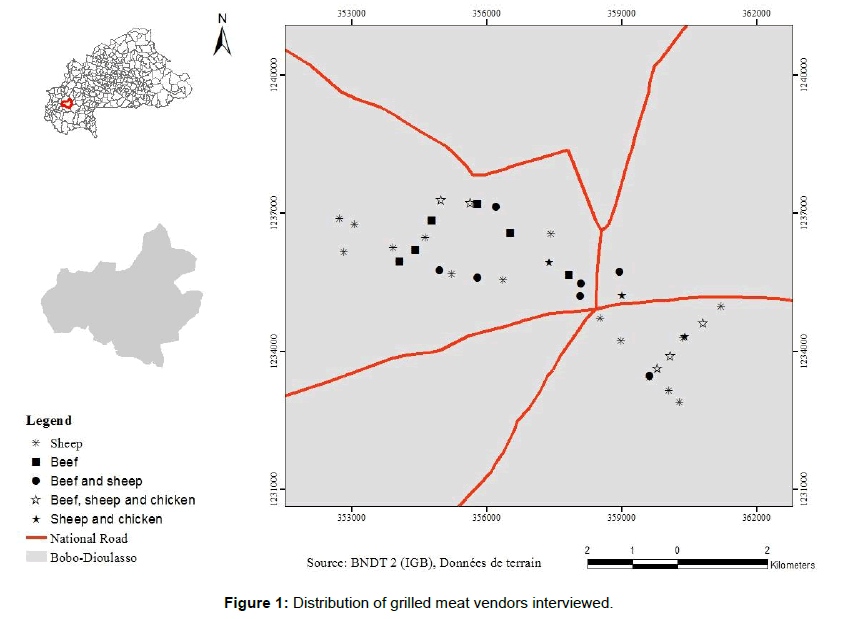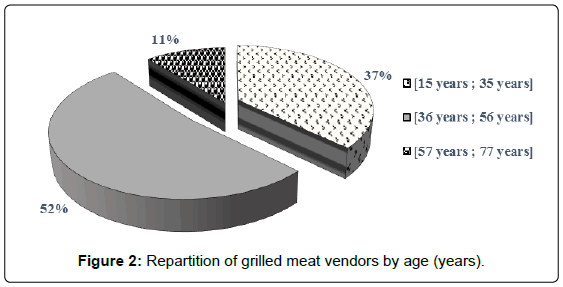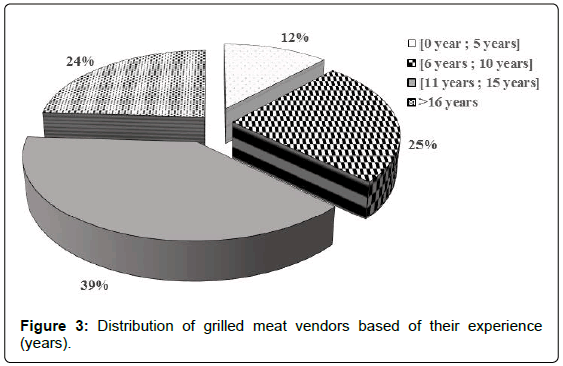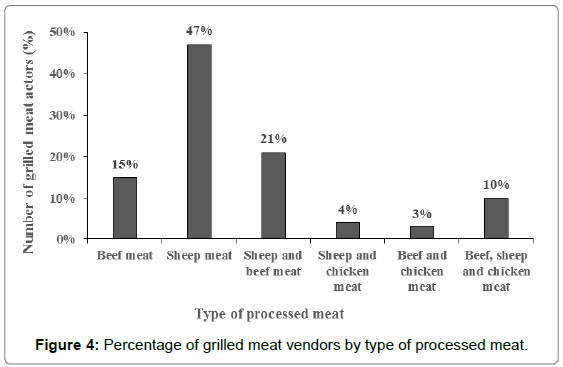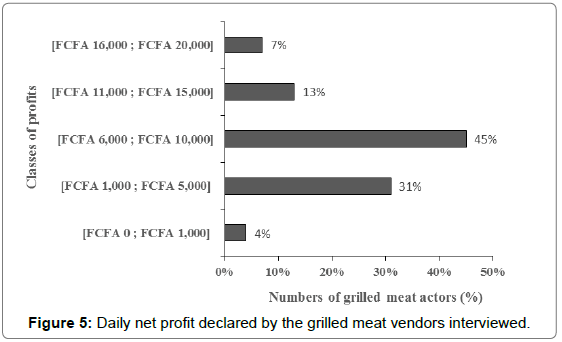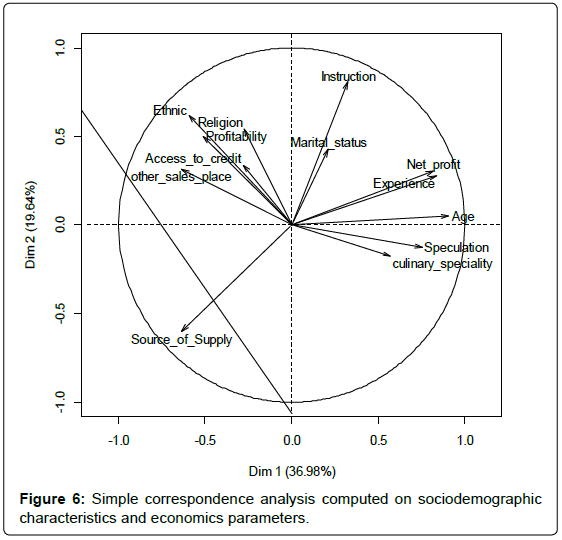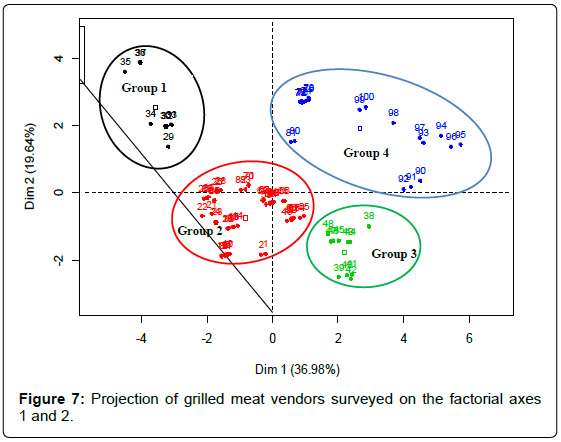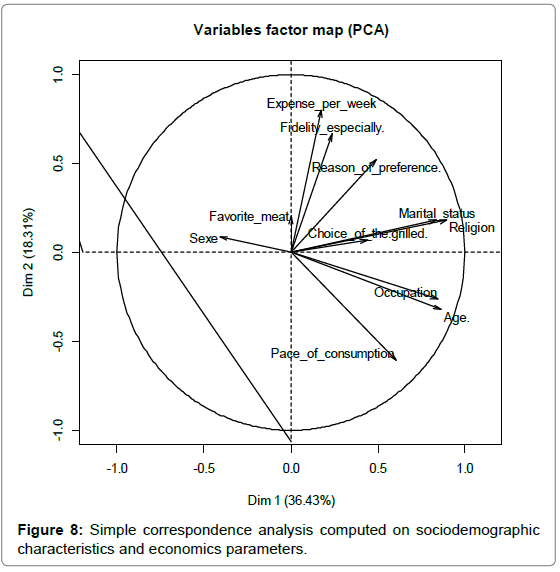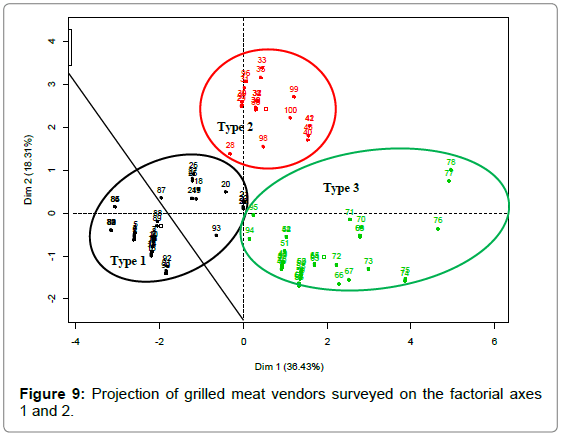Socio-Economic Determinants of Away-From-Home Grilled Meat Consumption and Typology of Grilled Meat Actors in Bobo-Dioulasso, West-Burkina-Faso
Received: 28-Nov-2017 / Accepted Date: 28-Dec-2017 / Published Date: 30-Dec-2017 DOI: 10.4172/2332-2608.1000256
Abstract
This study aimed to analyze the socio-economic determinants of away-from-home grilled meat consumption and then make the typology of grilled meat vendors and consumers. The study was conducted as a cross-sectional, general survey model. The sample group of the study consisted of 100 grilled meat vendors and 100 consumers who were selected using easy randomized sampling method. For data collection, we use survey and personal interview. Results revealed that there are four main types of vendors and three types of consumers. Younger grilled meat vendor was the type1 (9% of the sample) grouped the employees with an average net profit of 2028 ± 335 FCFA per day. They have no formal education and have never been to Koranic school either. The type 2 (59 % of the sample) under the responsibility of Professional of grilled sheep and beef meat, aged (34.5 ± 8.9 years) and experienced (8.9 ± 5.1years). This type of grilled meat vendors was made up mostly of Haoussa ethnics. They realize on average a profit of 8010 ± 3666 FCFA per day. The type 3 grouped only Haoussas ethnic (age 47.9 ± 4.0 years) and old experience (9.3 ± 1, 0 years). They are all owner and the majority of them have another grilled meat sale place with employees. They realize on average a profit of 10000 ± 5071 FCFA per day. The type 4 (21% of the sample) presented full professional of grilled meat. Haoussa and fulfulbé as ethnics (50.5 ± 9.2 years) and are considered as oldest in this activity. They realize on average net profit of 15571 ± 6451 FCFA per day. Consumers’typology are 1) Young and single consumers, 2) Married consumers and 3) Consumer, friend or relative of the grilled meat vendor.
Keywords: Grilled meat; Vendors; Consumers; Typology; Bobo-Dioulasso; Burkina-Faso republic
Introduction
Livestock production in Burkina-Faso constitutes a key activity in the live-hoods of the population and contributes actively to income generation [1]. It is practiced by more than 80 percent of rural households. The relative contribution of the livestock sub-sector to Gross Domestic Product (GDP) ranged from 18.3 percent and 19.5 percent over the period 2001 to 2008 [2]. From 2008 to 2012, the number increased from 8 M to 8.8 M for cattle and 19 M to 21.8 M for small ruminants [1]. Cattle, goats and sheep are numerically and economically the most important species of domestic animals [1]. For many smallholder farmers, domestic ruminants are the only ready and significant source of cash to buy items they cannot produce on their own or access free charge. Also most dietary protein in this region comes from animal sources, and a significant proportion of this is from domestic ruminants. Ruminants have the ability to convert plant material that is unsuitable for human consumption into high quality food products [3]. In addition, the main processing activity of livestock products in Burkina Faso is slaughter for meat production. And at the meat marketing level, meat grillers play an important role [1]. The grillers or street grilled meat actors evolve especially in the city, but also in the villages. They grill the meat in pieces and skewers mainly with small ruminant meat and secondarily with beef and chickens [4]. Also the marketing circuit of the local chicken in Burkina Faso shows that grillers or street grilled meat actors hold an important position [5]. Among street foods vendors at Bobo-Dioulasso, they are the majority. So as the case in the developing countries, they provide a source of affordable nutrients to the majority of the people [6]. They play a very important role in meeting food requirements of commuters and urban dwellers in many cities and towns of developing countries [7]. These foods are highly demanded both by the sellers and consumers because of their tastes, easy availability, low cost, cultural and social heritage connection, and being nutritional [2,3]. Regarding the employment, street food provides a good job opportunity and income for sellers with small capitals. These employment opportunities are good [8]. The meat sector in Burkina Faso is still poorly known, undocumented, lacks reliable and quantified data. It remains complex and dominated by informal and small-scale with numerous partners and intermediaries as well as the multiplicity of actors and their roles. So this research is conducted in a context where there is very little work devoted to the marketing, processing and consumption of away-from-home grilled meat consumption in Bobo-Dioulasso, West-Burkina-Faso. The purpose of the study is to analyze the socio-economic determinants of non-household meat consumption in the city of Bobo-Dioulasso and then identify the different categories of grillers and consumers according to socio-economic aspects. This study aims also to establish through surveys in herds, a typology of grilled meat vendors.
Material and Methods
Study area
The study was conducted at Bobo Dioulasso. The area of the study is the city of Bobo Dioulasso, (Coordinates 11 0 II '00 "North 40 17' 00" West) economic capital of Burkina Faso. Located at 365 km from the capital Ouagadougou, the city of Bobo Dioulasso is at once the administrative center of the Hauts-Bassins administrative region and the Houet province (Figure 1). The city of Bobo-Dioulasso is subject to a tropical south Sudanese climate characterized by a rainy season Guin in October) whose average rainfall is 1200 mm and a dry season (November to May). Potential evapotranspiration (FTE) varies between 1700 and 1800 mm per year [9]. The rains are relatively abundant but unequally distributed over time and space. According to the national meteorological data computed from the 1981-2010 averages recorded at the Bobo Airport station, the monthly average water level varies from 15 mm in March to 271 mm in August. As for temperatures, meteorological data from 1981 to 2010 show a monthly minimum average temperature of 18°C in January at 25 °C in May. Peaks range from 29°C in August to 37°C in March. The vegetation is characterized by a significant development of woody species made of wooded savannah, gallery forests along the main rivers are Kou and Houet. In the 2006 census, 497,191 people were identified in the city of Bobo- Dioulasso, consisting of 247,305 men (49.7%) and 250,486 women (50.3%). The average annual growth rate is 4.69%. The social groups that populate the city are mainly Dioula, Bobo and Mossi. The active population is 168,245, comprised of 116,090 men and 52,155 women; 54.8% of men and 24.3% of women [6]. In the active population, the breakdowns in the various occupational categories give: 46.5% in the occupation group "service personnel and salesmen"; 20.9% the second category of occupation "Crafts and workers"; 7.0% the third category of farmers, breeders and fishermen. These three categories alone account for 74.4% of assets. Activities: The economic sectors of Bobo-Dioulasso revolve around the following sectors: agriculture (cereals, vegetables, fruits); trade (large markets and commercial establishments); livestock (cattle market, box fattening, slaughter house); crafts and industry. In the city, the tertiary sector is dominant, followed by the secondary sector and the primary sector with contributions of 57%, 41% and 1.8%, respectively in the constitution of the Gross Local Product (PLB) (IRD, 2000). In urban and peri-urban areas of Bobo-Dioulasso, agricultural and livestock production units play an important role in supplying the city and providing jobs. However, the importance of agricultural units and livestock farms is not taken into account by urban planning departments who consider that these activities are incompatible with the development of the city.
Data collection and statistical analysis
A cross sectional survey of street grilled meat vendors and consumers in Bobo-Dioulasso town city was done between October and November 2017. There is no previous work on away-from-home grilled meat consumption has been done in Bobo-Dioulasso and therefore there were no records on vendors. Observations indicated that grilled meat actor mainly operated cross the road, near bars, as well as next to restaurant and hotels. Data were collected using semistructured interviews. So a semi-structured questionnaire was then developed and pre-tested on 10 grilled meat vendors operating in the Bobo-Dioulasso city. The study used both quantitative and qualitative data collection techniques. The questionnaire was adjusted accordingly to make it clear and include the most relevant aspects of grilled meat vendors in Bobo-Dioulasso. The final questionnaire had 36 questions and was divided into 3 sections; (i) demographic characteristics, (ii) contribution to economy, and (iii) knowledge about entrepreneurship and micro-enterprise registration. The questionnaire was administered through face to face interviews. Another survey was introduced to consumer.
Overall 100 grilled meat vendors and 100 consumers were interviewed. First the interviewers established the contact with each participant interviewed and introduced the objectives of the study. The interviews were conducted in the informants' local languages. The main objective of the interviews was to identify the determinants of awayfrom- home grilled meat consumption, a social characteristics of its all actors, its contribution to economy and set up the typology that help us to better understand the modes of operation of away-from-home grilled meat actors. Figures 1-4 show the distribution of interviewed based of their speculation.
The analysis of the different answers of all demographic characteristics was performed using Pearson Chi-square Test and Simple Correspondence Analysis. Also, an analysis of the variance was performed to assess the effects of the source of supply and the number of years of experience of grilled meat vendors on the buying price, the selling price and the profit obtained after meat processing. The separation of means in case of significant difference was made from the Newman-Keuls test. All statistical analyzes were performed with the SAS software. Differences are considered significant at 95% threshold (p ≤ 0.05). In add, Simple Correspondence Analysis was performed to evaluate the determinants of meat consumption and establish a typology of grilled meat actors in Bobo-Dioulasso city, dependency of socio-economic characteristics of the surveyed. Pearson Chi-square Test was performed using SPSS software (SPSS, 1996) while the Simple Correspondence Analysis was performed in SAS software (SAS, 1999).
Results
Demographic characteristics of away-from-home grilled meat vendors
The vendors interviewed mainly operated cross the road. All of the interviewed were men (Table 1). The age range 15-35 years accounted for 37% of the vendors where as 52% were aged 36-56 years and 11% aged 57-77 years (Figure 1). It should be noted that none of away-fromhome grilled meat vendors was older than 78 years old. The older had 62 years old.
| Number of grilled meat vendors (%) | ||
|---|---|---|
| Sex | Male | 100 |
| Female | 0 | |
| Religion | Islam | 81 |
| Christianity | 14 | |
| Animism | 5 | |
| Worker status | Owner | 72 |
| Employee | 28 | |
| Marital status | Single | 12 |
| Married | 88 | |
| Widowed | 0 | |
| Divorced | 0 | |
| Ethnics | Haoussa | 62 |
| Foulfoudé | 23 | |
| Dioula | 12 | |
| Mooré | 3 | |
| Educational level of vendor | None | 74 |
| Primary school | 6 | |
| Secondary school | 2 | |
| Koranic school | 18 | |
Table 1: Demographic characteristics of away-from-home grilled meat vendors.
Table 1 shows the demographic characteristics of grilled meat vendors interviewed. Eighty-eight percent of the vendors were married while 12% were single. There was no widowed and divorcee. The most of vendors (74%) had no formal education, and 18% had religion (Koran certification) (Table 1). There is a very few interviewed attended primary and secondary education respectively 6 and 2 percent. About ethnics of grilled meat vendors, the Haoussa (62%) represent the main ethnic group. Secondary we have Foulfoudé ethnics (23%) and the last ethnic of grilled meat activity in Bobo-Dioulasso are Dioula (12%) and Mooré (3%). For 72 percent interviewed, this activity is their own business and 28% are employed (Figure 2).
Figure 3 shows a distribution of grilled meat vendors based on their experience in the activity. It shows that only 12% of grilled meat vendors surveyed are at the beginning of the activity with an experience between 0 and 5 years. More than half (64%) have an experience of between 6 and 15 years with respectively 25% for 6 to 10 years and 39% for 11 to 15 years. Our investigation has also found that the activity of away-from-home grilled meat sales is an old job for some interviewed. 24% of respondents practice this activity from a young age and currently have more than 16 years of experience in this activity.
Table 2 summarizes the variations in ages and number of years of experience according to the total number of respondents. The different speculations of away-from-home grilled meat vendors and the types of meat processed in the city of Bobo are shown in Figure 3. It shows that the meat most processed by away-from-home grilled meat vendors is sheep meat (47%). 21 percent of grilled meat vendors specialized in the processing of both sheep and beef. 15percent of respondents only process beef and 10% process beef, sheep and chicken meat at the same time. Moreover, it is rare to see sheep and chicken association. A very few interviewed were specialized in both beef and chicken.
| Minimum | Maximum | |
|---|---|---|
| Ages (years) | 18 | 62 |
| Experience (years) | 1 | 40 |
Table 2: Variations in ages and number of years of experience.
Table 3 shows the membership of the grilled meat vendors in an association, access to credit and the desire to formalize their microenterprises. It shows that it is just 9% of respondents who are in favor of moving towards a formal structure. 61 percent dis-agree the idea to formalize their business with the reason of lack of awareness and explanation on the benefits that could motivate their choice. As for membership in an association, more than half (60%) are not members of any association, compared to 19% as an association member. Similarly, with respect to access to credit, the majority of the grilled meat vendors (52%) do not consider loans. 8 percent have once benefited from microfinance loans. 23 percent have applied for loans and 17% are thinking ask loans in the future.
| Number of grilled meat vendors (%) | ||
|---|---|---|
| Evolution towards a formal structure and the reasons for refusal | Favorable | 9 |
| No favorable (high tax) | 16 | |
| No favorable (random benefit) | 14 | |
| Non (No reason to motivate) | 61 | |
| Membership to an association | Member | 19 |
| No member to any association | 60 | |
| Absence of information | 21 | |
| Access to credits | Beneficiaries | 8 |
| Applied for loans | 23 | |
| Ask loans in the future | 17 | |
| Not considered | 52 | |
Table 3: Socio-entrepreneurial characteristics of grilled meat vendors.
Analyzes of economic aspects related to the activity of grilled meat
At the end of our survey, we had 91% of grilled meat vendors who said they were satisfied with the economic profitability of their business compared to 9% who said they were not satisfied. The survey also revealed that 27 percent of the grilled meat sellers have another grilled meat sale place, compared to 73% who are satisfied with their unique grilled meat sale place. Figure 4 shows the daily net profit margins reported by grilled meat vendors. 45% of respondents have a daily profit of between 6,000 and 10,000 FCFA, while 4% of respondents (all of whom are employees) have a low daily profit of between 0 and 1,000 FCFA. The grilled meat sellers who have declared a daily profit of 11000FCFA to 20000FCFA have at least two different places of sale of grilled meat with employees recruit.
Table 4 gives a global economic assessment of processed meats. It shows the mean of daily quantities of meat processed by grilled meat vendors. This table also allows us to understand that about chicken meat, the selling price is stable and identical to all grilled meat vendors. Also, there is not much variation in the profit obtained on chicken meat. Moreover for sheep and beef, the profit varies from one grilled meat vendor to another. The statistical analysis of the economic data collected from grilled meat vendors also shows that sheep and beef grilled meat are more profitable for vendors than chicken grilled meat. In addition, grilled beef meat per kilogram gives up to 1000 FCFA more profit than sheep grilled meat. A comparison of the means of profitability of the grilled meat sale activity was made according to the experience (older or number of years in the activity) of the grilled meat vendor and the place of supply. The results of the mean comparison test are recorded in the Table 5. This statistical analysis provides an understanding of the variation of profit of grilled meat vendors according their experience and the source of supply the raw material, the fresh meat. In general, the buying price is cheaper with the breeder compared to the slaughterhouse and the intermediate (fresh meat seller). According to the source of supply, about beef meat, there is no significant difference was recorded in profit. On the other hand, in the case of sheep, the grilled meat vendors who buy their raw material from the sheep's breeder make twice the profit of other grilled meat vendors who buy their fresh sheep meat at slaughterhouse and with the intermediate (fresh meat seller). In the same way the grilled meat vendors who get their raw material from the breeder make more profit than the others. As for the experience, the sellers of grilled meat with an experience more than 16 years buy the cheaper the fresh meat compared to the others. By the statistical analysis, we remark also that the experience in the grilled meat sales activity has no impact on profit with regard to sheep and beef meat. On the other hand, about chicken meat, the grilled meat vendors with experience (>16 years) have a high profit per grilled chicken sold compared to others.
| Quantities (Kg/ Day) | Buying price (FCFA/Kg) | Selling price (FCFA/Kg) | Profit (FCFA/Kg) | |
|---|---|---|---|---|
| Sheep meat | 43,62 ± 29,44 | 1596,21 ± 136,50 | 2231,82 ± 247,18 | 635,61 ± 322,34 |
| Beef meat | 13,48 ± 8,06 | 2203,12 ± 98,61 | 3846,88 ± 352,56 | 1643,75 ± 361,68 |
| Chicken meat | 11,29 ± 5,56 | 924,72 ± 111,25 | 1400 ± 0,00 | 475,29 ± 111,25 |
Each value is a mean ± standard error
Table 4: Global economic assessment of processed meats.
| Buying price | Selling price | Profit | ||
|---|---|---|---|---|
| Source of fresh meat provision | Sheep meat | |||
| Breeder | 1341,17 ± 93,93c | 2392,15 ± 285,16a | 1050,98 ± 363,26a | |
| Intermediate or Fresh meat seller | 1500,00 ± 38,49b | 2000,00 ± 121,72a | 500,00 ± 86,07b | |
| Slaughter house | 1666,67 ± 0,00a | 2203,03 ± 223,03a | 536,36 ± 223,55b | |
| Probability (p) | 0,003* | 0,011* | 0,014* | |
| Beef meat | ||||
| Breeder | 2016,67 ± 86,60b | 3900,00 ± 312,25 | 1883,33 ± 259,81 | |
| Intermediate or Fresh meat seller | 2175,00 ± 35,35a | 3600,00 ± 0,00 | 1425,00 ± 35,36 | |
| Slaughterhouse | 2250,00 ± 0,00a | 3847,30 ± 369,49 | 1597,30 ± 369,49 | |
| Probability (p) | 0,006* | 0,257NS | 0,070NS | |
| Chicken meat | ||||
| Breeder | 750,00 ± 38,30c | 1400,00 ± 0,00 | 650,00 ± 38,30a | |
| Intermediate or Fresh meat seller | 860,00 ± 28,28b | 1400,00 ± 0,00 | 540,00 ± 28,28b | |
| Slaughterhouse | 1000,00 ± 0,00a | 1400,00 ± 0,00 | 400,00 ± 0,00c | |
| Probability (p) | 0,000*** | 0,423NS | 0,000*** | |
| Experience of grilled meat vendors (older or number of years in the activity) | Sheep meat | |||
| [0; 5 ans] | 1666,67 ± 0,00a | 2133,33 ± 366,16 | 466,67 ± 366,16 | |
| [6; 10 ans] | 1666,67 ± 0,00a | 2222,99 ± 202,58 | 556,32 ± 202,58 | |
| [11; 15 ans] | 1611,90 ± 110,45a | 2250,00 ± 88,19 | 638,10 ± 151,19 | |
| >16 ans | 1392,16 ± 150,71b | 2286,27 ± 366,49 | 894,12 ± 498,36 | |
| Probabilité (p) | 0,014* | 0,589NS | 0,068NS | |
| Beef meat | ||||
| [0; 5 ans] | 2250,00 ± 0,00a | 3944,44 ± 608,50 | 1694,44 ± 608,50 | |
| [6; 10 ans] | 2250,00 ± 0,00a | 3937,5 ± 311,39 | 1687,50 ± 311,39 | |
| [11; 15 ans] | 2250,00 ± 0,00a | 3844,12 ± 133,32 | 1594,12 ± 133,32 | |
| >16 ans | 2045,45 ± 101,13b | 3845,45 ± 304,51 | 1800,00 ± 297,49 | |
| Probabilité (p) | 0,006** | 0,867NS | 0,670NS | |
| Chicken meat | ||||
| [0; 5 ans] | - | - | - | |
| [6; 10 ans] | 1000,00 ± 0,00a | 1400,00 ± 0,00 | 400,00 ± 0,00b | |
| [11; 15 ans] | - | - | - | |
| >16 ans | 786,67 ± 65,32b | 1400,00 ± 0,00 | 613,33 ± 65,32a | |
| Probabilité (p) | 0,029* | 0,423NS | 0,030* | |
Each value is a mean ± standard error. Figures with different letters in the same column by speculation and source of fresh meat provision or grilled meat vendors experience are significantly different at the 5% threshold according to the Newman-Keuls test.
NS: not significant; *: significant difference at the 5% threshold; **: significant difference at the 1% threshold ***: significant difference at the 0.1% threshold. (-) no grilled meat vendors belonging to this class
Table 5: Impact of the grilled meat vendor's experience and the source of supply fresh meat on the profit.
Typology of Grilled Meat Actors in Bobo-Dioulasso
Development of the typology of grilled meat vendors
The first two axes computed by Simple Correspondence Analysis on sociodemographic characteristics of grilled meat vendors and economics parameters (Figure 5) explained 54.22 % of the information. The contribution and representation quality of sociodemographic characteristics and economics parameters between the two axes was high on the first axis for the age, experience, profit per day, educational level and access to credits.
The social characteristics: Marital status and Religion also contributed highly on the first axis. The Ethnics, Profitability, Evolution towards a formal structure, Worker status, Membership to an association, Owner of another grilled meat sale place, had a good contribution and representation quality on the second axis. Considering the first axis, we observed that source of provision or approve visionment mostly contribute to Profit net per day.
The first factorial axis opposes on the one hand the grilled meat vendors with high experience in the exercise of this activity, which generate a very high daily net profit, doing all the speculations (beef, sheep and chicken meat) with the culinary offering skewers and grilled meat; and own more than one grilled meat sale place. On other hand the younger, employees with a few year experience in grilled meat activity, using only sheep meat speculation which they offering as grilled meat, and generating little daily net profit. This axis characterizes the economic variables of this activity.
The second factorial axis differentiates on the one hand, the grilled meat vendors who have been at Koranic School; who are fulfudé as ethnics and married, not considering access to credit and loans, and get the raw material, fresh meat directly with breeders or intermediate. On the other hand, we have the single people, grilled meat vendors; who have no formal education, and who buy only at slaughterhouses. This factorial axis characterizes the socio-demographic variables of the grilled meat vendors and source of supply of meat. Four types of grilled meat vendors can be identified, these are:
Type 1 (9 grilled meat vendors or 9% of the sample) - Younger grilled meat vendor, beginner: The grilled meat vendors of type 1 are all employees. They are very young with an average age of 20.8 ± 1.5 years, single and are very little experience (2 ± 1 years) in this activity. They manage only one grilled meat sale place and get their supplies from slaughterhouses in the city. They have no formal education and have never been to Koranic school either. They process only sheep meat. They are not satisfied with the profitability of this activity. Indeed, they realize an average profit of 2028 ± 335 FCFA per day (Figure 6).
Type 2 (59 grilled meat vendors or 59% of the sample) - Professional of grilled sheep and beef meat: The grilled meat vendors of type 2 are majority Muslim. This category of grilled meat vendors includes young people of average age of 34.5 ± 8.9 years, experienced (8.9 ± 5.1 years). They are all owner of one grilled meat sale place. This type of grilled meat vendors was made up mostly of Haoussa ethnics, but also Dioula and Mooré. They have not received any formal education. They buy fresh meat in slaughterhouses. Their speculation are both beef and sheep meat. Their culinary offering is grilled meats and skewers. These are grilled meat vendors who claim to be satisfied with the profitability of this activity. They realize on average a profit of 8010 ± 3666 FCFA per day.
Type 3 (11 grilled meat vendors or 11% of the sample) - Haoussas, Owner multiple place of grilled meat sales: All grilled meat vendors of type 3 are married and Haoussa as ethnics (mean age 47.9 ± 4.0 years) and old experience (9.3 ± 1, 0 years). They are all owner and the majority of them have another grilled meat sale place with employees. For supply the raw material, fresh meat, they buy all beef, mutton and chicken meat at slaughterhouses. For these grilled meat vendors, this activity is profitable and they consider other sources of funding. As culinary offering, they cook grilled meats, skewers and soups. They realize on average a profit of 10000 ± 5071 FCFA per day.
Type 4 (21 grilled meat vendors or 21% of the sample) - Full professional of grilled meat: The grilled meat vendors of this type were Haoussa and fulfulbé as ethnics. They have an average age (50.5 ± 9.2 years) and are considered as oldest in this activity with about twenty years of experience. They haven't necessarily several grilled meat sale place but are very satisfied with the profitability of their activity. Specially, this type of grilled meat vendors use very less the slaughterhouses. They use as raw materials source directly breeders, intermediaries or traders. In general they make a lot more profit on the kg of meat sold compared to the others grilled meat vendors. They process all sheep, beef and chicken meat and they offer only grilled meat. Some members in this category have already taken out loans. They realize on average a profit of 15571 ± 6451 FCFA per day.
Development of the typology of grilled meat consumers
The first factorial axis opposes, single young women consumers of grilled meat, students with older and married consumers. This axis is strongly represented by the socio-demographic variables of the consumers. The second factorial axis distinguishes on the one hand the consumers having a very high expenditure per week for the grilled meat and who haven't only one place to buy the grilled meat, are not faithful to only one grilled meat vendor. On the other hand, consumers with a very high rate of consumption, not considering too hygienic standards, and choosing the place of purchase of grilled meat according to the good cooking of the grilled meat vendor. Three (3) categories of consumers have been identified.
Type 1 (32 individuals, 32% of the sample): Young and single consumers: The majority of this type of grilled meat consumers is young and single with an average age of (23.2 ± 5.5 years). All professions are represented in this group, but the most are students. Moreover, both sexes are present in this group with more men. The consumers of this group prefer and buy very often a grilled sheep meat compared to other meats. According to them, they like sheep meat because that is the tastiest meat. They are not faithful to one grilled meat place. Their only criteria for choosing the grilled meat vendor is his good cooking and culinary offering. They don’t consider hygienic standards or relationship with the vendors. They spend on average 987.5 ± 333.2 FCFA per week.
Type 2 (26 individuals, 26% of the sample) - Married consumers: They are young and married with an average age of (33.7 ± 9.1 years). They are all civil servants, of Muslim religion for the majority. In this group we find both men and women, with a dominance of men. They prefer beef and sheep meat. Their criteria for choosing the grilled meat vendor are the quality of his welcome and his ethics, and then his good cooking. The average expenditure on meat was high (2007.1 ± 395.4 FCFA) for consumers of this type.
Type 3 (42 individuals, 42% of the sample): Consumer, friend or relative of the grilled meat vendor: They are older consumers and married. They are for the majority of artisans, professionals of small enterprises and breeders. They based on friendship and relationship to choose the place where buying grilled meat. They don't consider hygienic standards and quality of cooking. They regularly use one place to buy grilled meat. They are faithful to the grilled meat vendor. They have not a particular preference. They buy beef, mutton and chicken meat as well. The average meat expenditure was 1006.8 ± 240.1 FCFA for consumers of this type (Figures 7-9).
Discussion
Our study found that all grilled meat vendors interviewed were men. This disagree Muyanja et al. [10] who explain that in any speculation of street food activity, women predominate. In street food sector in Uganda, 87.6% were made up of women with low education. In Maseru City, Lesotho the majority of street the vendors were women [11]. Our investigate revealed that the Haoussa (62%) represent the main ethnic group. Secondary we have Foulfoudé ethnics (23%) and the last ethnic of grilled meat activity in Bobo-Dioulasso are Dioula (12%) and Mooré (3%). Meat profession and consumption depends on socio-economic factors, ethnics or religious beliefs and tradition. Most of individual socio demographic factors play a key in determining both the probability participation and the quantity consumed level of the meat and meat products [12]. It was stated in a research that street food has socioeconomic and cultural influences as they reflect historical roots [13]. It is also mentioned that although modern fast food consumption is being spread, still the consumption of street food continues all around the world traditionally. Our study show that the age range 15-35 years accounted for 37% of the vendors where as 52% were aged 36-56 years and 11% aged 57-77 years (Figure 1). It should be noted that none of away-from-home grilled meat vendors was older than 78 years old. The older had 62 years old. In the Central State of Northern Nigeria. 56.4% of the street food vendors were within 30 to 39 years. 10.9% were less than 30 years and 8.2% of the vendors were above 50 years. Majority of the vendors (80.9%) were women. 66.4% of the street food vendors had either primary or no education. Only 2.7% of them had tertiary education [14]. In order to be knowledgeable of marketing activities, processing and consumption of pork meat in N’Djamena and surrounding areas, a study conducted by Mopate et al. [15] revelated that the pork meat vendors were young and educated men with mean between 31 and 45 years. Ackah and Gyamfi [16] found out that in Accra-Ghana, street food sellers earned 84% of their main income from their sales and that 80% of the sellers were aged between 25-50. Regarding the employment, street food provides a good job opportunity and income for sellers with small capitals. That employment opportunities are good [8]. Our investigation has also found that the activity of away-from-home grilled meat sales is an old job for some interviewed. 24% of respondents practice this activity from a young age and currently have more than 16 years of experience in this activity. Fifty two percent of the vendors operated the street food vending business on individual basis. It was concluded that while street food vending in Maseru can be viable [11]. The results found out that the meat most processed by away-from-home grilled meat vendors is sheep meat (47%). 21 percent of grilled meat vendors specialized in the processing of both sheep and beef. 15 percent of respondents only process beef and 10% process beef, sheep and chicken meat at the same time. This is contrary with the results of Inan et al. [17] in their study about meat products meat consumption in Aksehir, Turkey. According to the results, goat meat was found to be consumed at the lowest level (24.9%) among meats. When considering meat consumption frequencies of participants, beef held the first rank (95.5%) and mutton/ lamb (54.5%) and goat (24.9%) were followed it respectively. The differences of meat consumption rates were caused by regional and cultural (e.g., cuisine) and socio-demographic and economic discrepancies [18]. Finally the first place of sheep meat consumption in this study can justify by the fact that Sheep and goat meat has several health benefits in comparison to other red meat), which also potentially coincides with advantages with respect to environmental impacts and animal welfare. The relatively low beef consumption level also reflects that, to some extent, a cattle protecting ideology still exists in rural areas due to the fact that cattle have traditionally been used as working animals [19]. 61 percent of grilled meat vendors surveyed dis-agree the idea to formalize their business with the reason of lack of awareness and explanation on the benefits that could motivate their choice. About Formality and Regulation of Street Food Vending, 98.3 percent of the businesses were not registered by the Harare City Council [20]. About the economic profitability, 91% of grilled meat vendors said they were satisfied with the economic profitability of their business. Although street food vending is illegal, it significantly helped to reduce unemployment, increased incomes of vendors and provided urban dwellers with inexpensive and varied indigenous meals [20]. The study of Mopate et al. [15] about pork meat sales and consumption found out that the traders profits varied between 6 820 F/male and 7 670 F/female. Lower gross profit of processors was 4 200 F/carcass. And majority (65%) of them rate mostly fried and oven-cooked meat while drinking industrial alcoholic beverage in nearly bars. However, a minority (35%) met places where local beer is consumed preferred mostly skewers and soup along with traditional alcoholic beverages [15]. The daily net profit reported by grilled meat vendors differed with the vendor’s experience. More the experience is, more the net profit. This can be explained by their good knowledge of market circuit and their older in this activity. The raw materials supply has impact on profitability. Usually these types of grilled meat vendors get fresh meat from breeders and in general, the buying price is cheaper with the breeder compared to the slaughterhouse and the intermediate. About the consumers, the young and married (men and women), all civil servants aged (33.7 ± 9.1 years) have a high expenditure per week. In add, this type of consumers consider some hygienic and quality to choose the grilled meat vendors. The study about socio-economic determinants of consumer fish purchase in Windhoek, Namibia confirmed that strong income, age, marital status and household size effects on the purchase of fish species [21]. Consumer education level was found to be an important factor for healthy diet behavior. Education and income levels influenced purchasing criteria of beef consumption [22]. According to Inan et al. [17], the knowledge of quality evaluation of the consumer is to interact between perceptions, physical product and process attributes [23]. Also the price can assist consumers inferring product quality and forming quality expectations, which in turn influence a whole range of attitudes and behaviors related to food purchasing, meal preparation, satisfaction and future purchase decisions [24]. For away-from-home meat consumption, in addition to income and urbanisation, other factors, such as the employment status of the woman (wife), number of males in the household, and the presence of children affect total away-fromhome food consumption in different ways. Consequently, these factors would affect the quantity and variety of meat items consumed when eating out [19]. Our study show that 42% of consumer based friendship and relationship to choose the grilled meat vendors. This is emphase with Rheinlander et al. [25] who explained in this study, consumers’ strong reliance on personal trust in vendors. Their result found out that most consumers also expressed that trust in the vendor was important when choosing a safe place to eat, this trust was built on previous positive experiences or social/family relationships and not on food safety assessments. Such trends of high personal trust in vendors were also found among vendors and consumers in an Ugandan street food study [26,27]. Measuring the determinants of pork consumption in Bloemfontein, Central South Africa the relationship between pork consumption and socioeconomic characteristics shows that average income, monthly expenditure on meat and price of substitutes for pork-consuming households are higher than for non-pork-consuming households [28,29].
Conclusion
Four types of grilled meat vendors were distinguished in the Bobo- Dioulasso city in the west of Burkina-Faso. These four types differed in the age and ethnicity of the grilled meat vendor, number of year or experience in the activity, Net profit per day, source of fresh meat supply, speculation and culinary offering.
Three types of grilled meat consumers were distinguished. They differed each other in the sex of consumer, marital status, occupation, favorite meat and reason of preference, grilled meat expense per week and pace of consumption, choice of the grilled meat sale place and fidelity especially to the grilled meat vendor
Acknowledgements
The authors express their gratitude to the Organization for Women in Science for the Developing World (OWSD) for funding this study and the grilled meat vendors of Bobo-Dioulasso city for their frank and valuable cooperation during this study.
References
- FAO and ECOWAS (2016) Review of livestock / meat & milk sectors and the policies that influence them in Burkina Faso: 73.
- Tamini LD, Fadiga ML et Sorgho Z (2014) Chaines de valeur des petits ruminants au Burkina Faso: Analyse de situation. ILRI Project Report. Nairobi, International Livestock Research Institute (ILRI): 156.
- Sidibe-Anogo AG, Ouedrago GA, Ledin I (2006) Effect of partly replacing cottonseed cake with Mucuna spp. (var.Ghana) hay on feed intake and digestibility, milk yield and milk composition of Zebu cows. Tropical Animal Health and Production 38: 563-570.
- Ministère des Ressources Animales (MRA) (2007) Plans d'actions pour le développement des filières bétail-viande et petits ruminants (Première partie): Diagnostic des filières. Rapport final.
- Kondombo SR (2008) Review of the poultry sector: Importance and prospects of the poultry sector in Burkina Faso. Food and Agriculture Organization.
- Muzaffar AT, Huq I, Mallik BA (2009) Entrepreneurs of the Streets: An Analytical Work on the Street Food Vendors of Dhaka City. International Journal of Business and Management 4: 80-88.
- Tambekar DH, Kulnari RV, Shirsat SD, Bhadange DG (2011) Bacteriological quality of street vended food Panipuri, A case study of Amravati city (MS) India. Bioscience Discovery 2: 350-354.
- Barro N, Nikiema P, Ouattara CAT, Traoré AS (2002) Evaluation de l’hygiène et de la qualité microbiologique de quelques aliments rue et les caractéristiques des consommateurs dans les villes de Ouagadougou et de Bobo-Dioulasso (Burkina Faso). Rev Sci Tec Sci Santé 25: 7-21.
- Chung C, Ritoper S, Takemoto S (2010) The importance of street foods for the poor in Bangkok, Thailand, Bangkok and access to food for low-income residents, Massachusetts Institute of Technology. Boston 18: 210.
- Muyanja C, Nayiga L, Brenda N, Nasinyama G (2011) Practices, knowledge and risk factors of street food vendors in Uganda. Food Control 22: 1551-1558.
- Gadaga TH, Ntsike MM, Ntuli V (2011) Socio-economic and hygienic aspects of street food vending in Maseru City, Lesotho. USWA Research Journal of Agriculture, Science and Technology 15: 28-39.
- Karli B, Bilgic A (2007) Factors affecting meat and meat products consumption quantities in Sanliurfa province. Mediterrranean Agricultural Sciences 20: 127-136.
- Buscemi S, Barile A, Maniaci V, Batsis JA, Mattina A, et al. (2011) Characterization of street food consumption in Palermo, possible effects on health. Nutrition Journal 10: 119.
- Nurudeen AA, Lawal AO, Ajayi SA (2014) A survey of hygiene and sanitary practices of street food vendors in the Central State of Northern Nigeria. Journal of Public Health and Epidemiology 6: 174-181.
- Mopate YL, Koussou MO, Kabore-Zoungrana CY, Gouro A (2006) Commerce et consommation de viande porcine dans la zone de N’Djaménan (Tchad). Revue sénégalaise de la recherche agricole et agroalimentaire.
- Ackah M, Gyamfi ET (2011) Socio-Economic profile, knowledge of hygiene and food safety practices among street-food vendors in some parts of Accra-Ghana. Internet Journal of Food Safety 13: 191-197.
- Inan SST, Ebru B, Ali CM, Nazan A (2016) Consumers’ meat and products Consumption frequency, knowledge levels and quality cues: the sample of aksehir, Turkey. Pakistan Journal of Nutrition 15: 540-546.
- Ulas B (2011) Factors affecting consumer decision on red meat and chicken meat consumption in urban area of Aydýn province, Gaziosmanpasa Uni. Dep of Agric. Econom, Tokat.
- Liu HB, Deblitz C (2007) Determinants of meat consumption in China. Asian Agribusiness Research Centre (AARC).
- Njaya T (2014) Operations of street food vendors and their impact on sustainable urban life in high density suburbs of Harare, in Zimbabwe. Asian Journal of Economic Modelling 2: 18-31.
- Musaba E, Namukwambi M (2011) Socio-economic determinants of consumer fish purchase in Windhoek, Namibia. African Journal of Agricultural Research 6: 1483-1488.
- Liu H, Deblitz C (2007) Determinants of beef consumption in China. Working Paper 41, Asian Agribusiness Research Centre (AARC) Charles Sturt University, Australia.
- Grunert KG (2006) Future trends and consumer lifestyles with regard to meat consumption. Meat Science 74: 149-160.
- Grunert KG (2005) Food quality and safety: consumer perception and demand. European Review of Agricultural Economics 3: 369-391.
- Rheinlander T, Olsen M, Bakang JA, Takyi H, Konradsen F, et al. (2008) Keeping up appearances, perceptions of street food safety in urban Kumasi, Ghana. Journal of Urban Health 85: 952-964.
- Hansen J, Holm L, Frewer L, Robinson P, Sandøe P (2003) Beyond the knowledge deficit: recent research into lay and expert attitudes to food, risks. Appetite 41: 111-121.
- Oyewumi OA, Jooste A (2016) Measuring the determinants of pork consumption in Bloemfontein, Central South Africa. Agrekon 45: 185-197.
- Laforteza JJ, Gaudiose M, Tan J (2014) Determinants of accounting practices among street food vendors. International Journal of Accounting and Financial Management Research: 2249-6882.
- Grunert KG, Bredahl L, Brunso K (2004) Consumer perception of meat quality and implications for product development in the meat sector. Meat Science 66: 259-272.
Citation: Montcho M, Babatounde S, Yameogo VB, Aboh AB, Mensah GA (2017) Socio-Economic Determinants of Away-From-Home Grilled Meat Consumption and Typology of Grilled Meat Actors in Bobo-Dioulasso, West-Burkina-Faso. J Fisheries Livest Prod 5: 256. DOI: 10.4172/2332-2608.1000256
Copyright: © 2017 Montcho M, et al. This is an open-access article distributed under the terms of the Creative Commons Attribution License, which permits unrestricted use, distribution, and reproduction in any medium, provided the original author and source are credited.
Select your language of interest to view the total content in your interested language
Share This Article
Recommended Journals
Open Access Journals
Article Tools
Article Usage
- Total views: 4895
- [From(publication date): 0-2017 - Aug 03, 2025]
- Breakdown by view type
- HTML page views: 4039
- PDF downloads: 856

